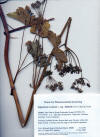|
Ligusticum apiifolium
|
Ligusticum canbyi Idaho: North-central, Clearwater Natl. For., Eldorado Creek near jct. with Dollar Creek, 46º17.964, 115º38.776, elev. 3,540 ft, wetland prairie with dominant Veratrum californicum surrounded by forest of Englemann spruce, subalpine fir, western red cedar, lodgepole pine, western larch. 26 July 2011
|
|
Ligusticum grayi California—Cascade Mts. Shasta Trinity NF: 8.5 mi northeast of Weed on east side of Hwy 97; 41º31'00.5", 122º18.24.6", 1079 m. Basalt flow with perennial herbs of Eriophyllum, Eriogonum, Phacelia linearis, P. heterophylla. Aromatic perennial from a long tuberous root; flowers pale yellowish green. Locally abundant on lava. Separate samples of root (rt) and aerial parts (st-lf-fl). Richard Spjut & Paul Burchstead 16338, 10 June 2008. |
Ligusticum scoticum |
|
Juan S. H., C. H. Chen, Y. H. Hsu, C. C. Hou, T. H. Chen, H. Lin, Y. L. Chu and Y. M. Sue. 2006. Tetramethylpyrazine protects rat renal tubular cell apoptosis induced by gentamicin. Nephrol. Dial. Transplant. “Gentamicin, a widely used antibiotic for the treatment of bacterial infection, can cause nephrotoxicity. Tetramethylpyrazine (TMP) is a compound purified from the rhizome of Ligusticum wallichi (Chuanxiong) and has been found to protect against ischaemia-reperfusion injury, nephritis and alcohol-induced toxicity in rat kidneys. We used rat renal tubular cells (RTCs), NRK-52E, in this study. The cytotoxicity of gentamicin was checked with transferase-mediated deoxyuridine triphosphate nick end-labeling (TUNEL) staining, and the generation of reactive oxygen species was measured using the fluorescent probe 2,7-dichlorofluorescein. We evaluated several apoptotic parameters: cleaved caspase levels, tumour necrosis factor (TNF-alpha) excretion and nuclear factor Kappa B (NF-kappaB) activity. We also examined the TMP protective effect on gentamicin-induced apoptosis in rat kidneys. The results of this study showed that gentamicin was found to markedly induce apoptosis in NRK-52E cells in a dose-dependent manner; that TMP expressed a dose-dependent protective effect against gentamicin-induced apoptosis; that pre-treatment of the cells with 50 or 100 muM of TMP effectively decreased the reactive oxygen species formation induced by gentamicin; that TMP was found to inactivate the gentamicin-stimulated activities of caspase-3, caspase-8 and caspase-9, to inhibit gentamicin-induced release of cytochrome c, as well as to raise the expression of Bcl-x(L); that TMP inhibited the gentamicin-induced TNF-alpha excretion, and inactivated the transcription factor NF-kappaB; and that the TMP treatment significantly reduced apoptotic injury in rat RTCs. Based on the results of this study, we suggest that TMP can attenuate gentamicin-induced oxidative stress and apoptotic injury in rat RTCs, and that its character may have therapeutic potential for patients with renal diseases.” Szeto Y. T. and I. F. Benzie. 2006. Is the yin-yangNephrol Dial Transplant. 2006 Nov 28 nature of Chinese herbal medicine equivalent to antioxidation-oxidation? J. Ethnopharmacol.108(3): 361–366. “It has been suggested that yin-yang theory described in traditional Chinese medicine is somewhat equivalent to the modern theory of antioxidant-oxidant balance. Some yin-tonic Chinese herbal medicines possess antioxidant properties. In this context, the DNA protective effect of 12 yin-tonic and 13 yang-tonic herbs were tested using the single cell gel electrophoresis (comet) assay. Lymphocytes from three healthy subjects were pre-incubated with aqueous herb extract, and the comet assay was performed on treated, untreated, challenged and unchallenged cells in parallel, oxidant challenge being induced by 5min exposure to hydrogen peroxide. Results using this ex vivo cellular assay showed protection by some herbs. Seven out of 12 yin-tonic Chinese herbs demonstrated decreased DNA damage after treatment while 10 out of 13 yang-tonic herbs showed protection. Among 25 herbs tested, rhizome of Ligusticum sinensis Oliv. and aerial part of Artemisia annua L. demonstrated greatest DNA protective effect. Results indicated that the yin nature of herbs may not be necessarily associated with superior antioxidative effect to yang-tonic herbs, at least in terms of DNA protection against oxidant challenge.” |
|





